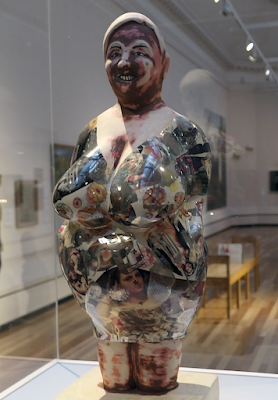 |
Grayson Perry, Melanie, 2014 |
Having responsibility for an art gallery is something of a
challenge these days. When I visit a gallery with a permanent collection, such
as York, I imagine the curators having sleepless nights about how to present it.
Outside, the world is shouting (quite rightly) for equal rights, sexual
equality, political justice, much which seem to be diametrically opposed to
many of the works in the collection. Like most galleries, York has plenty of old
paintings: a Saint Sebastian with arrows through him, a St Barbara being
whipped, a male model strung up with cords, and so on – not the kind of images
you would want to present without some explanation. How does a gallery deal
with this challenge?
York Art Gallery’s response is quite dramatic. The main gallery is largely handed to members of the York LGBT community, who appear to have chosen the paintings displayed and added captions to them. A second room devoted to paintings is entitled “Treasures from the Stores”, although it includes some of the best-known pictures from the collection. Finally, a couple of big rooms are allocated to the ceramics collection, a highlight of the collection.
When it comes to ceramics, you feel the curators breathe a sigh of relief. I didn’t see any pots with arrows stuck in them, and you would think that for the most part ceramics are sufficiently abstract for them to cause no offence. There was a quiet, contemplative feel about the ceramics galleries that is welcome; one wall, the Wall of Women, was dedicated to female artists. The almost homely feel was greatly helped by the lovely display of the Anthony Shaw collection, over 1,000 pieces, displayed in what feels like a domestic environment, with rugs, a fireplace and mantelpiece. The individual works are not captioned, although with a bit of detective work you can find out who did what. Overall, there is a warm feeling to the space.
York Art Gallery is distinctive for its collection of contemporary ceramics, which, they say, is unequalled in the UK. It’s certainly one of the most imaginative presentations, something like Kettle’s Yard for porcelain.
As for the paintings, you feel the gallery curators are almost embarrassed by their collection. As a gesture, they invited local gay people to select paintings from the collection and to add their comments alongside.
Many of the captions seem to be determined to read things
into the picture that do not seem warranted by the work itself. For example, one
gay commentator claims that Anna Hudson’s The Visitor “is representing her own
reality as a queer individual … the figure’s obscured facial features suggest a
struggle with identity”. Well, it may be, but Sickert, Hudson’s contemporary,
painted many figures with obscured faces, and we don’t immediately jump to similar
conclusions about them.
My final example of imaginative over-readings of a painting things is Composition, by John Banting. This work is a kind of still-life: a depiction of a classical bearded head (stated to be Greek in the caption, but could equally be Roman), a couple of mussel shells, plus a blackboard with an upturned squiggle. Out of this the commentator suggests “Does Banting long for Greece and its queer, starlit beaches?” Difficult to imagine, from the work in front of us.
Of course, the main thing is that galleries are visited. There
was a healthy number of people visiting the gallery on the Saturday afternoon
when we were there, and they represented a wide range of ages – both a good
sign. There was a tiny but inviting café, and a shop selling very interesting
ceramics. All in all, a satisfying experience. Even though I never worked out
why the medieval painter should focus on St Barbara was being whipped, I did
enjoy Grayson Perry’s Melanie: a lovely, rounded figure, full of joie de
vivre.







